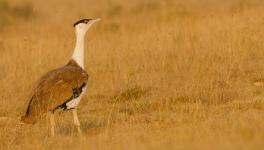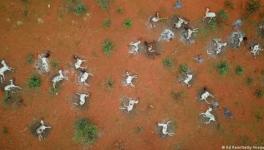Why India Should Assess Biodiversity Impacts as Part of ‘Green Energy’ Proposals
On April 19, 2021, the Supreme Court constituted a committee to examine the feasibility of under-grounding of power lines. The order follows a petition which pointed out that collision with power lines was the major cause of deaths of Great Indian Bustards (GIBs).
According to the Rajasthan-based ERDS Foundation, since May, 2017, at least seven GIBs have died in Rajasthan after coming into contact with high power transmission lines that connect solar and wind farms to grids.
India has a population of less than 150 GIBs. What the deaths mean, therefore, is that India has lost at least 4% of its GIB population in four years owing solely to badly planned 'green energy'. The International Union for Conservation of Nature (IUCN) categorises GIBs as "critically endangered" at a global level.
According to local estimates by ERDS, thousands of other birds have also either died or were injured owing to wind and solar power generation in Rajasthan. The list also includes species like Laggar falcons which IUCN categorises as "near threatened".
India’s courts have recognised disastrous impacts of renewable energy on avifauna in Rajasthan. But, it’s not just Rajasthan. And it’s also not just avifauna.
Most prominently, adverse impacts of Andhra Lake Wind Farm in Maharashtra on local biodiversity were documented by the Western Ghats Ecology Panel chaired by Madhav Gadgil, submitted to Ministry of Environment, Forest and Climate Change (MoEFCC).
Also read: SC Orders Laying of Cable Transmission Lines Underground in Great Indian Bustard Habitats
“Fossil fuels are seen as bad. Renewables are seen as the solution,” said Priya Pillai, senior researcher at Asar. But, this myopic perspective is the problem, she pointed out. “Just because the energy source is ‘greener’, it does not mean the system has changed or that the way capital behaves has changed,” she added. In the context of socio-ecological impacts of renewables, Pillai noted issues like land grabs and illegal usage of water as fallouts of large-scale solar plants.
And, as for biodiversity impacts, she pointed to habitat loss fragmentation which impedes wildlife movement.
“Installation of panels requires changes in the landscape like clearing the vegetation and removal of the top soil. There’s also significant impact from other infrastructure like when access roads are built. And when it comes to wind power, there are so many reports pointing to how birds get caught in the turbines and in power transmission lines,” Pillai explained.
Pointing at the Kamuthi Solar Power Project in Madurai, Tamil Nadu and Pavagada Solar Park in Karnataka, she explained, “Both these places are water-stressed regions and both these plants have been illegally extracting water from nearby water bodies. So, in addition to [further] depleting water levels in the region, there is an impact on migratory birds which visit these water bodies.”
IUCN too recognises that “clean energy sources” like wind and solar entail adverse impacts on biodiversity via “disturbance and loss of habitat, the generation of noise pollution, collision and other indirect pressures”.
Given projections of India going beyond its 2022 renewable energy target of 175GW and likely reaching 220GW, it is important to bear in mind fallouts of like biodiversity loss in what appears to be a narrow focus on decarbonising the energy sector.
Currently, India does not have a regulatory framework to govern solar and wind energy projects. Both of these are not covered under the Environmental Impact Assessment (EIA) Notification 2006 and so, they don’t need an environmental clearance. These projects do require a clearance under the Forest Conservation Act, 1980, if forest land is to be used. But if the land is not forest land, there is no question of environmental assessment at all, let alone biodiversity assessments.
A framework to assess biodiversity impacts of ‘green energy’
“In environmental clearances under the EIA Notification, there is very little focus on biodiversity impacts,” said Abhishek Pratap, senior researcher at Asar. Environmental assessments under EIA largely include issue like soil, air and water pollution.
There’s also the issue that biodiversity is largely looked at from a forest perspective. “We have this view that wildlife is only in forests. That’s why we only have Forest Conservation Act [alongside] the Wildlife Protection Act. We need to go beyond this and recognise non-forest lands that support biodiversity like agricultural lands,” Pratap said. Other non-forest lands that harbour rich biodiversity include grasslands, wetlands, scrub forests and deserts.
Also read: Great Indian Bustard: Is it ‘Tilting at Windmills’?
Renewable power companies are taking “great advantage” of lands in western Rajasthan which are not declared as protected areas, said Sumit Dookia, a wildlife biologist at Guru Gobind Singh Indraprastha University in New Delhi and scientific adviser to the ERDS Foundation. Desert National Park is the only protected area in the region and the remaining lands are with the Revenue Department or with local communities. “The companies take these lands on lease and directly setup their [solar and wind] plants because there is no need [according to Indian laws] for any kind of biodiversity impact assessment,” Dookia added.
Pointing to the existing biodiversity frameworks elsewhere, Dookia noted how biodiversity assessment is mandatory for wind energy projects in Rajasthan which have obtained international funding from bodies like Asian Development Bank and World Bank.
“In my opinion,” Dookia said, “there should be guidelines for assessing impacts of renewable energy projects on schedule I species under the the Wildlife Protection Act and those recognised as ‘critically endangered’ and ‘endangered’ in the IUCN red list.”
However, Pratap noted, “If we start assessing biodiversity impacts, we should do it across the energy sector, not just for renewables.”
(The author is a freelance reporter whose work focuses on climate change and wildlife.)
Get the latest reports & analysis with people's perspective on Protests, movements & deep analytical videos, discussions of the current affairs in your Telegram app. Subscribe to NewsClick's Telegram channel & get Real-Time updates on stories, as they get published on our website.
























